In December 2022, I started going to a rowing gym in Manayunk called RowZone. I had never rowed in my life, but I was interested in trying out rowing because I had heard that it was a low-impact cardio workout (running destroys my knees), and it works around 85% of the total muscles in your body. The gym offered cheap, instructor-led classes, which was great for me because I don’t like working out on my own and I would need additional instruction since I didn’t know how to row at all. The gym was also just 5 minutes from my apartment, so it was easy and convenient to access.
I didn’t know what to expect from the classes, but I quickly learned 2 things. First, we were using rowing machines for everything and not going on the water. Second, it wasn’t strictly a rowing workout—it was more like a HIIT workout that incorporated rowing as one of the main elements. Here’s an example of the kinds of workouts we would do in the class:
Sample RowZone Workout
Total time: 45 minutes
3 minutes: Warm Up. Row at light pace for 1:30, stretch as needed for remaining 1:30
After completing the rowing meters, cycle through and repeat the exercises until time is up
7 minutes: Row 1000m —> 10 squats / 10 deadbugs (5L, 5R) / 10 overhead press
3 minutes rest
7 minutes: Row 1000m —> 10 lunges (5L, 5R) / 10 kb swings / 10 zottman curls
3 minutes rest
5 minutes: Row 500m —> 10 calf raises / 20 ab twists (10L, 10R) / 10 bent over rows (5L, 5R)
2 minutes rest
5 minutes: Row 500m —> 10 step-ups (5L, 5R) / 20 bicycles (10L, 10R) / 10 bench dips
2 minutes rest
3 minutes: Row 250m. 10 kb fig-8 / 10 sec plank / 5 thrusters
1 minute rest
3 minutes: Row 250m. 5 squats / 5 jackknives / 5 pushups
1 minute rest
Rowing was completely foreign to me, as were many of the exercises we’d do in between the rowing portions. Thankfully, the instructors were extremely helpful and taught me everything I needed to know. I started going to RowZone 2–3 times a week, and I quickly saw my rowing technique improve and my body get more muscular and fit.
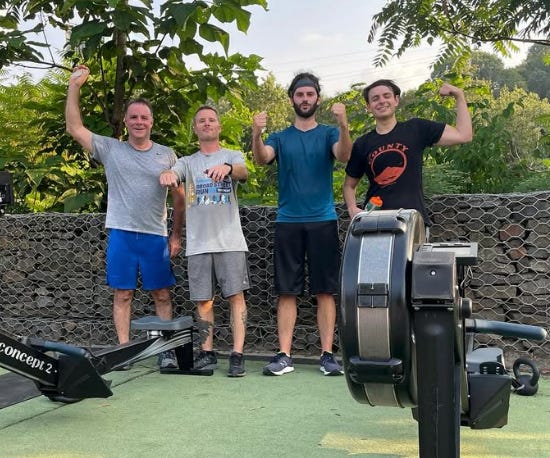
I loved going to RowZone! I was enjoying working out for the first time in my life, which led me to working out consistently for the first time in my life. And the community of people there, both instructors and participants, was really great. One of our instructors worked as a high school rowing coach and would frequently go out onto the water with his students. During the off-season, he’d be able to take us out on the water, too:

From December 2022 to August 2023, I had been going to RowZone workouts 2–3 times per week. But in September 2023, my wife and I moved into a home that was about 30 minutes away from Manayunk and RowZone. Even though I loved RowZone and wanted to keep rowing and working out in general, it didn’t feel worth it to commute an hour multiple times a week for workouts I could technically do anywhere. I started looking into the local Planet Fitness, and even considered buying my own rowing machine to use at home. Before I made any big decisions, my brother made one for me: he bought me a rowing machine for a housewarming/wedding gift present! I bought some weights and other equipment to create my own little workout station nestled in my home office.
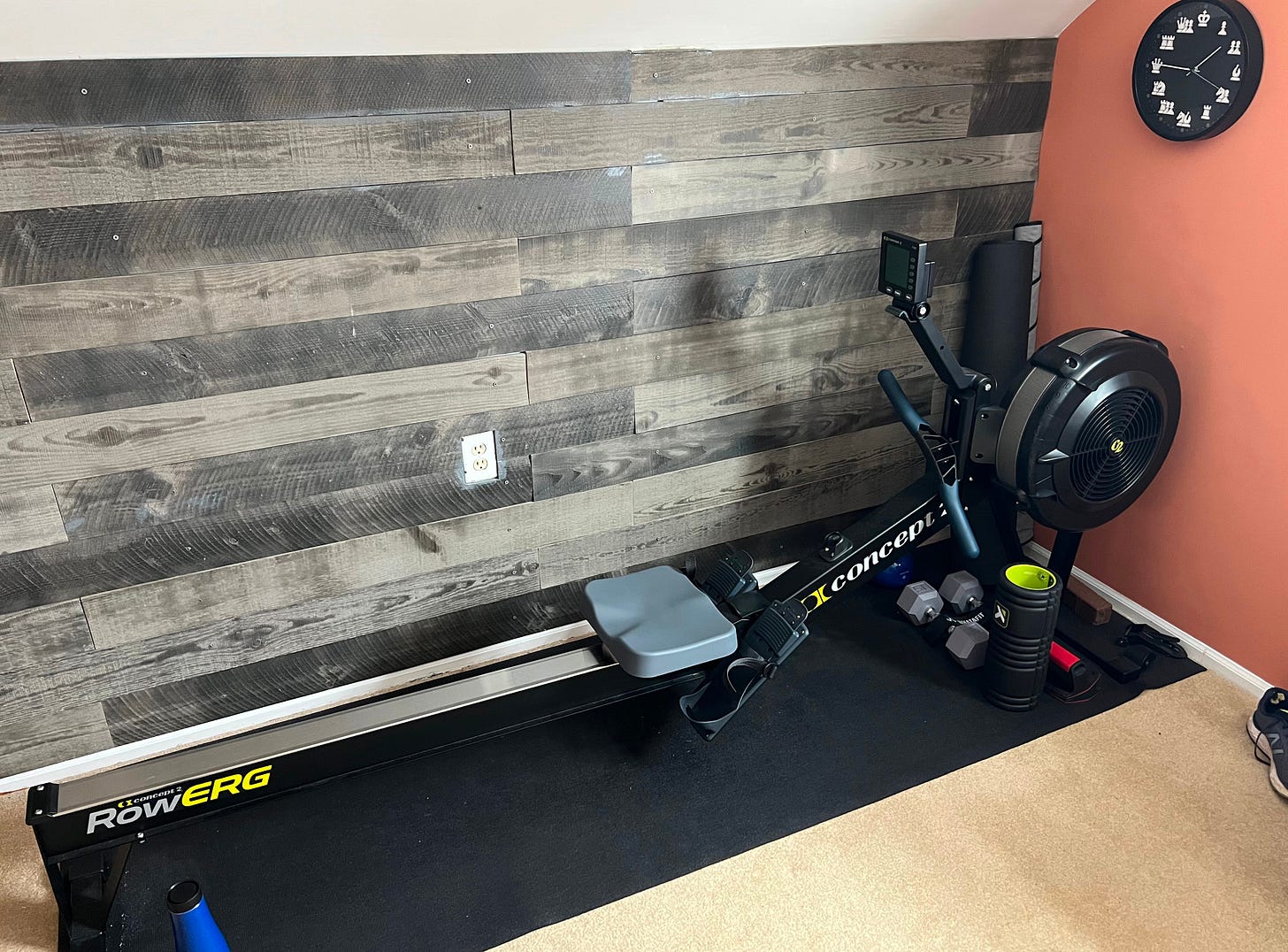
I started creating and doing workouts that were very similar to what I had done at RowZone—HIIT workouts that combined short-interval rowing with floor exercises. I did this for a while, but these RowZone-style workouts were much less satisfying to me at my home gym than they were at RowZone. At RowZone, there were instructors and participants all having fun and encouraging one another throughout the workout. RowZone also had an abundance of space to move around as you worked out, which was a stark contrast from my cramped, in-office gym. But I think the biggest factor that made my home workouts less fun was that I now had to create and manage the workouts for myself. I couldn’t just show up to my gym, turn my brain off, and start working out like I could at RowZone—I now had to plan the workout beforehand and manage the interval times while I was actually working out. I really didn’t like this, so I needed to try something different.
I learned at some point that Concept2 (the company that makes my rowing machine) also publishes a “Workout of the Day” that you can load into your machine and follow. Here is the first Workout of the Day that I completed:
Your workout for Wed Jun 12 2024
12 x 250m / 45 sec easy
12 intervals of 250 meters. 45 seconds of light rowing between intervals.
Unlike RowZone which incorporated rowing into a HIIT workout, Concept2’s Workout of the Day is always pure rowing—you’re never off the machine doing something else. Additionally, you can load the workout into your rowing machine via their app, and it sets up and manages the workout for you. Using the Workout of the Day above as an example, you could load it into the machine and start rowing. The machine would track your rowing progress until you’ve rowed 250 meters, then it would stop the rowing interval and start a rest interval for 45 seconds. Then when the rest interval ends, the next 250 meter interval would start, followed by 45 seconds of rest, and so on.
The Workout of the Day changed daily, was published by Concept2, and managed my workout for me by syncing my phone and rowing machine. That is to say, it immediately solved the biggest issues I’d had with doing RowZone workouts at home (creating and managing my own workouts). On top of that, the Workout of the Day introduced a brand-new metric into my workouts that really motivated me.
When you complete a Workout of the Day from a machine that is synced to the Concept2 app on your phone, the app collects your performance data and places it onto a public leaderboard1 with everyone else who completed that day’s Workout of the Day. This lets you compare your performance with every other person who did the workout of the day. Here is my performance from that first Workout of the Day I shared earlier:
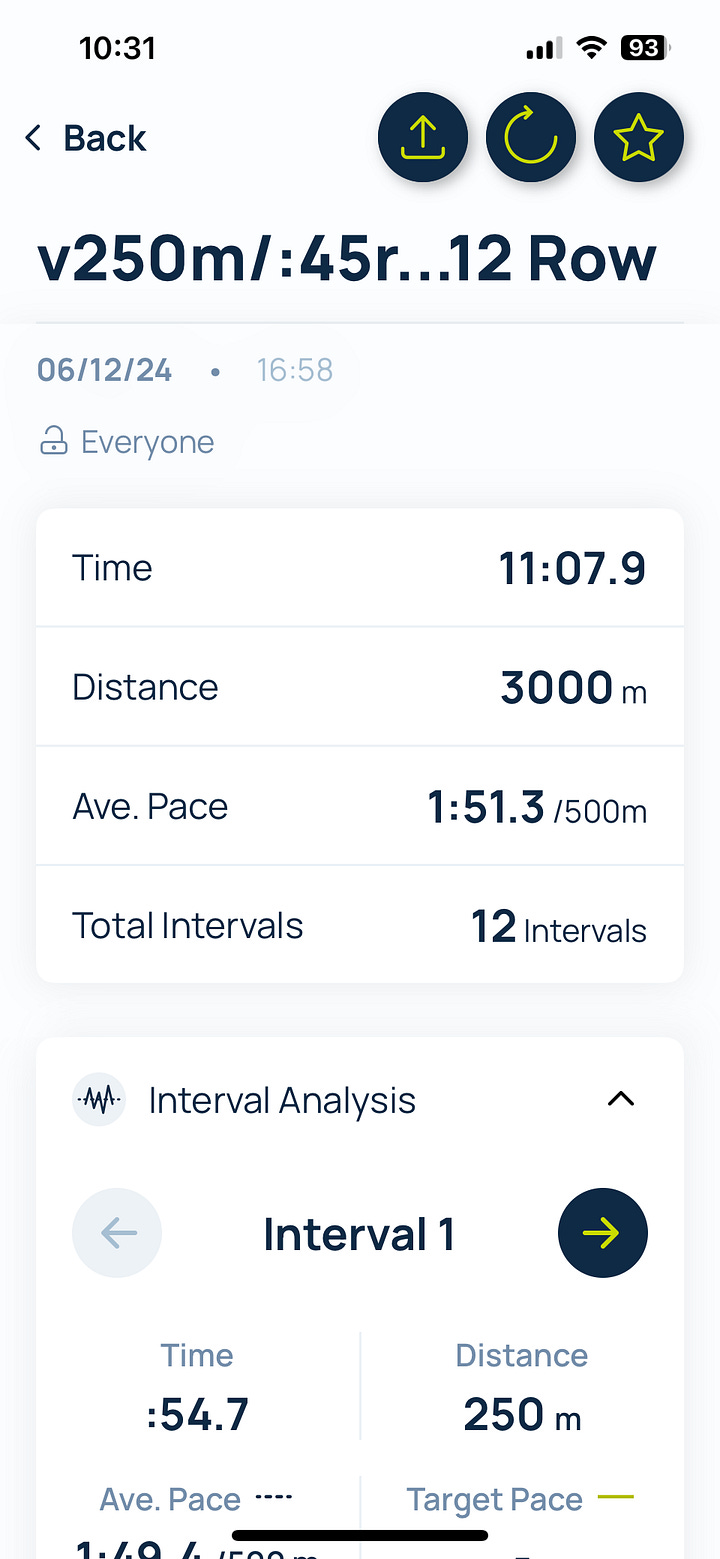
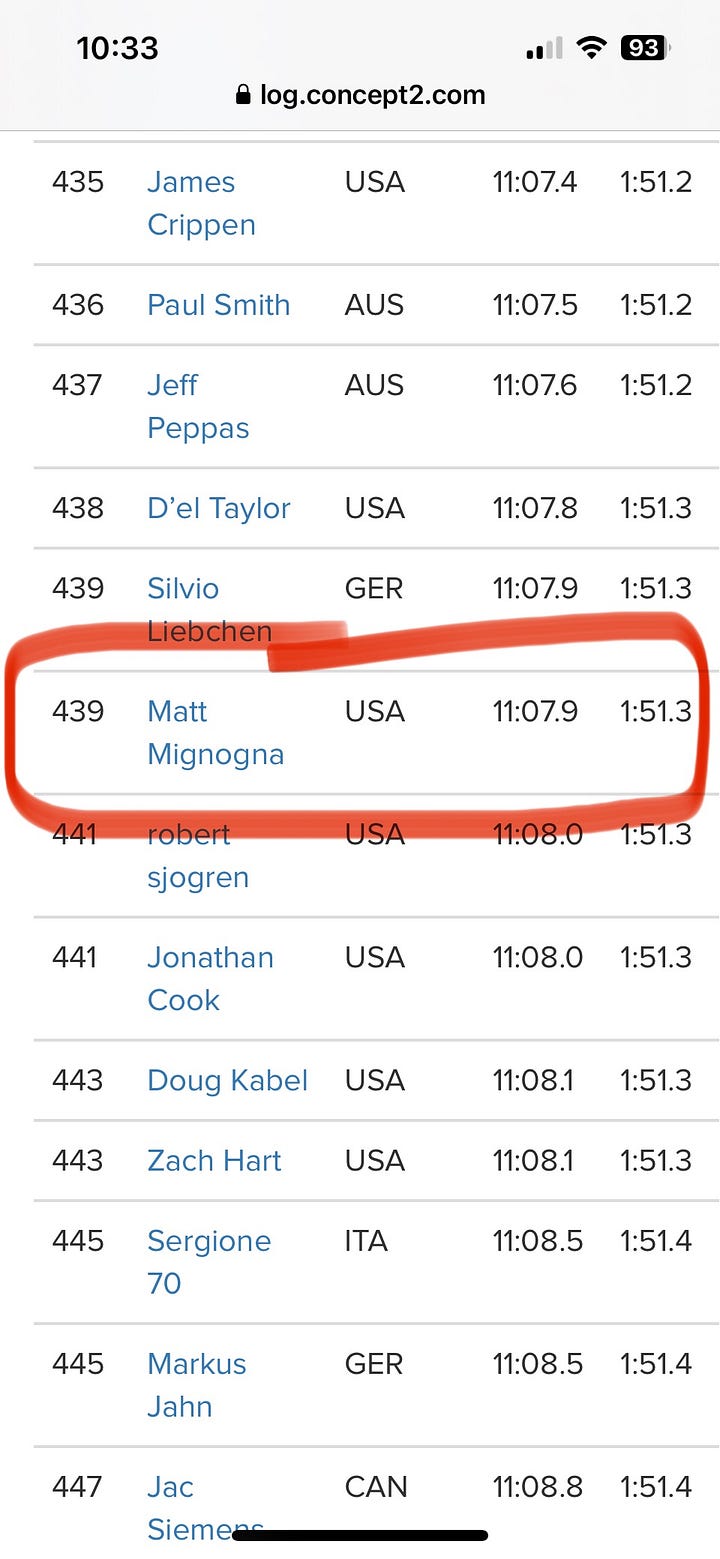
There were 1716 people who completed the Workout of the Day on June 12, 2024, which means my rank of 439 placed me in the top 25.6 percent. This ranking system and percentage score motivated me to perform better and get back into working out three times a week (prior to this, I hadn’t worked out at all for months after losing motivation for my at-home RowZone workouts). I wanted to see how much I could improve over time if I kept doing these workouts, so I started to graph my percentile score after every workout. Here is that graph, starting from my first Workout of the Day score on June 12 (25.6%) through the next 6 months:
My Workout of the Day scores started around 25% and slowly improved over the next 3 and half months to scoring in the top 5 percent! From mid-September on, I was consistently scoring between the top 10 and top 5 percentile.
I was extremely happy and proud of this—in just 3 months, I had improved much more than I thought was possible, and I had the numbers to prove it! But there was a part of me that wondered if the scores I was getting actually meant anything outside of the narrow context of Concept2’s Workout of the Day. For instance, how would my scores translate to the performances of people who row competitively on the water?
Fortunately, I had a friend who was on the Miami University2 club rowing team. He told me that in order to make their team, you had to row 5000 meters at a weight-adjusted time of 17:49 or faster. I didn’t know what a “weight-adjusted time” was, so he explained how rowing on the water is very different from rowing on a machine. A rowing machine will just calculate the work you put into it regardless of your weight. But on the water, your weight and the boat’s weight submerge the boat to a certain extent, which affects factors like water resistance, buoyancy, and ultimately your performance. I don’t pretend to understand all the specifics of it, but the point is that your weight doesn’t influence your output on a machine whereas your weight does influence your output on the water.
So there has to be a way to account for differences in weight when evaluating individuals’ performances on rowing machines. That’s what weight-adjusted time is: a time based on your weight that shows how your performance on a rowing machine would translate to a performance on the water. My friend also sent me a site that can calculate this for you, the Concept2 Weight Adjustment Calculator.
Around this time in early December, I was about 195 pounds. I played around with the calculator and saw that at my weight of 195 pounds, I would need to row 5000 meters in 19:09 or faster to have a weight-adjusted time that meets Miami University’s club rowing threshold of 17:49.

I had no idea how prepared I’d be for a workout like this because I didn’t know if the improvements I had seen in the Workout of the Day exercises would translate to this. Additionally, the vast majority of my rowing experience was in short intervals ranging from 1–5 minutes. The Miami University club rowing tryout was almost 20 minutes of uninterrupted rowing, and I suspected I wouldn’t have the stamina to actually finish it in the time required.
On December 6, 2024, I loaded the workout into my machine and began rowing. Was I able to row 5000 meters in 19:09 or faster? Here was my result at the end of the workout:
I completed the 5000 meters in 19:02.2, which means…I did it! I made the club rowing team at Miami University!3 I plugged my result into Concept2’s weight-adjustment calendar and saw that my 195 lb weight-adjusted time was 17:43.4, about 5.5 seconds faster than Miami University’s tryout threshold 17:49.0. Whoo!
When I started attending RowZone classes in December 2022, I had no experience with rowing whatsoever—I just wanted to work out consistently and get in better shape. By December 2024, exactly two years later, I had improved to the point where I could make a collegiate club team. For somebody who never had no knowledge of the sport and had never rowed before, I’m thrilled with all the progress I made!
After I achieved this, I wondered how I wanted to move forward with rowing. Do I continue trying to improve my average percentile for the Workout of the Day exercises? Do I try to improve my club rowing tryout time or learn what time I’d have to hit to make a non-club team somewhere? Do I try to spend more time rowing on the water? Do I stick with rowing at all?
I don’t know. I’m working on figuring that out. But in the meantime, the Workout of the Day isn’t going to row itself.
If you want to see my rowing scores and graphed results, you can find that in my rowing spreadsheet.
They actually call their leaderboard an “Honorboard” because none of the times submitted and posted are independently verified. Yes, the machine and app accurately track the work that was done on the machine—but it’s easy to cheat the machine. For example, you could have someone much better than you row under your account name. You could also have multiple people swapping in and out on the same machine during the workout to preserve energy levels.
I once found a result sitting at the very top of the Honorboard that was clearly fake/wrong. I sent the following email to the Concept2 support staff:
Hello,
The top score for the Workout of the Day for 9/18/2024 is impossibly high. It has over 1.5 million meters and a pace of 0:00.2.
This should be removed because it is impossible and distorts the average completion time ranking that is displayed.
Thank you very much!
I don’t even know how that score happened. I would guess it was a glitch in the machine/app because I can’t think of a way the rowing machine could be physically moved that quickly. Concept2 removed the score from the Honorboard after I sent the email.
Anyway, before I wind up writing a second post in the footnotes of this post, I just wanted to say that I think the name “Honorboard” perfectly represents what it is and is also very clever.
“Miami University” is a university located in Oxford, Ohio, and is named after the nearby Miami Valley. It is often confused with the “University of Miami,” a university located in Coral Gables, Florida that is named after nearby Miami, Florida. Neither of these universities are located in a city called Miami.
After writing this bit, I realized that I didn’t know my exact weight when I satisfied the Miami University club rowing tryout time. I said that I was around 195 lbs, and that was true: I was 195.6 lbs when I weighed myself that morning. But the workout data shows that I worked out at 12:37 pm, not in the morning. By that time of day, I likely weighed more than 195.6 lbs. Since I made the cutoff time by just about 5.5 seconds, I thought it was possible that my increased weight at the time of rowing could have put me out of the threshold I needed. So…I did the workout again on 1/10/24. This time, I weighed myself right before I started the workout: I was 201.0 lbs, which meant my weight-adjusted time to beat was rowing 5000 meters in 19 minutes and 1 second (technically 19:00.9).
I completed the workout in 18:56.7! This gave me an adjusted-weight time of 17:45.1, which was under the adjusted-weight time threshold of 17:49. I still made the team :)



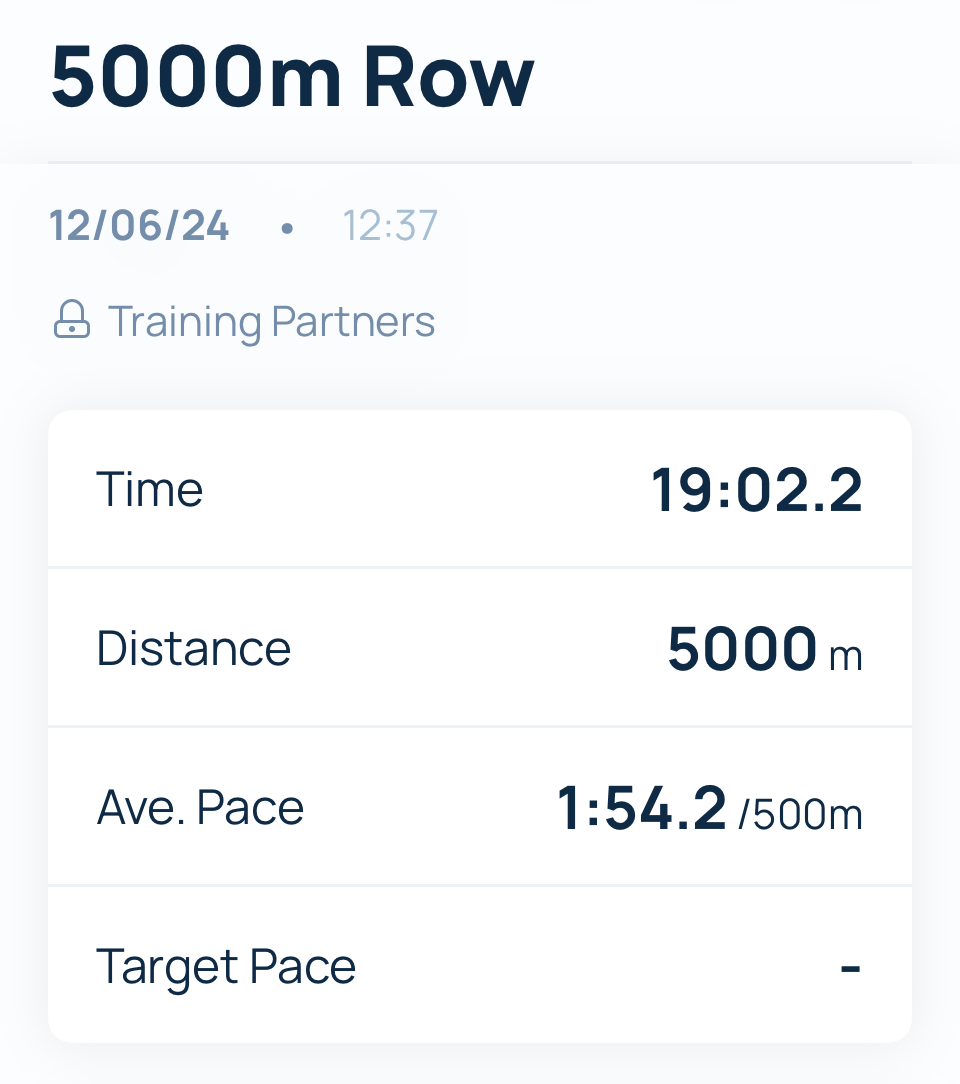
“Weight adjusted”….. suuuuuure